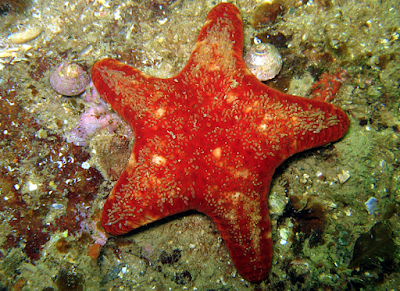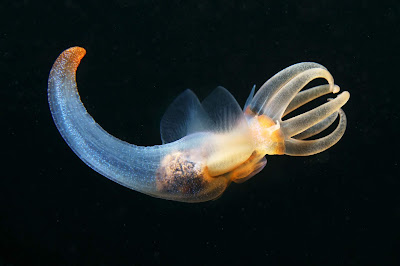‘Tis the season to enjoy friends, family, food and frolic. While adults rush around checking off to-do lists and decorating their homes, kids anxiously await Santa’s arrival.
Creatures under the sea don’t have to worry about what to buy Aunt Martha for Christmas, but some sea animals do share the holidays, in a sense. These animals are named after familiar holiday symbols, or even Christmas itself. Below are just a few of the many ocean residents with unique, festive names.
Candy Cane Shrimp
Candy cane shrimp resemble the famous holiday treat for which they are named. They share their living space with goby fish. The goby will hover over the shrimp, always keeping its fin attached to the shrimp’s antennae. If there is danger, the goby will flick its tail and send a signal to its shrimp partner. Their relationship extends beyond safety, as the two also share living and eating arrangements. The shrimp (who have very bad eyesight) bury themselves into the ground while the goby will use its great eyesight to keep watch. Even after the goby finds a mate, it will still inhabit the same burrow with its family and the shrimp. What a partnership! Check out the video here
White Christmas Tree Worm
The festive Christmas tree worm lives on tropical coral reefs, and resembles a fluffy fir tree, including its own unique “ornaments”! Its appendages look like branches, which are used to breathe and to catch floating plankton. Yum!
The angel shark buries itself into sand and mud at the bottom of the ocean floor, with only its eyes poking out. They can lie there for days at a time, waiting for the perfect holiday meal to swim by. When this shark strikes its prey, its front half rises and it ambushes the prey from below. It can attack and capture its prey in a tenth of a second, making its behavior less than virtuous.
Snowflake Moray Eel
They say no two snowflakes are alike, and each is beautiful in its own way. However, this particular snowflake is a bit scary! A snowflake moray eel eats its prey by utilizing two toothy jaws. It has a second set of jaws in its throat, which shoot up and grab its meal from the main pair of jaws. Its saving grace is its distinctive appearance. The snowflake moray eel has white, black and yellow splotches all over its body, which come together to look like snowflake designs!
Christmas Tree Worm
The Christmas tree worm isn’t interested in eating your fir tree. The name for these worms is derived from their appearance, not their habitat or diet. Each worm has two brightly colored crowns that protrude from its tube-like body. These Christmas tree-like crowns are composed of radioles, which are hair-like appendages. The appendages are used for respiration and to catch dinner, which typically consists of microscopic plants, or phytoplankton, floating in the water. The worms are sedentary, meaning that once they find a place they like, they don’t move much. In fact, while the colorful crowns of these worms are visible, most of their bodies are anchored in burrows that they bore into live coral. Much like the brightest of holiday lights, Christmas tree worms come in a variety of lively colors. Learn more about them here.
Reindeer Wrasse
The reindeer wrasse is a stunningly beautiful fish. Their heads are nearly scaleless, except for two scales on the upper part of the gill coverings and an almost vertical row of small scales behind each eye. The most obvious characteristic that gives this fish its common name is only present when the fish are juveniles. As youngsters, they possess distinctive, long ‘antlers’ (these are formed by the elongation of the dorsal fin). Their color resembles algae, which helps them avoid danger. Reindeer wrasse mimic the movements of detached, drifting seaweed by swaying back and forth in the currents.
Fairy Basslet
Fairy basslets are small, vibrant fish. While not adorned with traditional Christmas colors, their body is split into two colors– a purple front and a yellow tail, with a black spot on their dorsal fin; a truly stunning sea resident! Fairy basslets are known to swim upside-down under ledges and along cave ceilings. They live in colonies and defend their territory from other species, and even other fairy basslets. Male fairy basslets are excellent Dads, who guard and care for eggs and nests.
Cookie-cutter Shark
Looking more like a Halloween character than a Merry Christmas one, the cookie-cutter shark’s appearance is menacing. Even scarier, their name comes from how they feed. They eat smaller animals (like squid) whole, but also take large, round, cookie-cutter shaped bites out of larger animals, such as tuna, whales, dolphins, and seals. The shark suctions onto its larger prey, and twists around to take a bite of flesh using a row of sharp teeth.
Snowflake Coral
Appearing sweet and innocent, the snowflake coral possesses white frilly tentacles which, when extended, resemble rays of a snowflake. Primarily found in sheltered and shaded crevices, or in shallow caves on deeper reefs, snowflake coral have tiny stinging cells in their tentacles, which enable the capture of motile zooplankton. This species is of high concern due to its invasive nature. It causes the mortality of black coral, which it has been known to smother. So much for Christmas cheer.
Pinecone Fish
Pinecone fish look like real pinecones! They are covered in large scales with a dark trim. They are found lurking in caves and under ledges in the Indian and Western Pacific Oceans. Pinecone fish have a light-producing organ on both sides of their head. The light is produced by luminescent bacteria, but its function is unknown.
Harp Sponge
This newly discovered sponge was found 10,000 feet below the water’s surface, using robotic submersibles operated by the Monterey Bay Aquarium Research Institute. This carnivorous sponge traps small crustacean prey with barbed hooks found along its branch-like limbs. Check it out!
Sea Stars
Sea stars have toothless mouths on the underside of their bodies, which are lined with hundreds of tiny tube feet. Christmas-colored sea stars include the red velvet star and green linckia, which despite its name, comes in other colors as well. Sea stars can also be reddish or almost golden in color. When small, they often look like Christmas cookies! Sea stars may have spines, knobs, bristles, or a smooth-feeling texture. Most can regenerate an arm if they lose one.
Sea Angels
Reminiscent of a freshly made snow angel, sea angels are actually shell-less sea snails. Unlike most snails, they flap their adapted foot ‘wings’ to get around in the water. They are extremely small, with the largest species reaching only 5 centimeters long. Sea angels' mostly eat their own relatives, the sea butterflies.
Do you know of other sea residents with fun holiday names? Share your discoveries below!















No comments:
Post a Comment
Thank you for your comment!